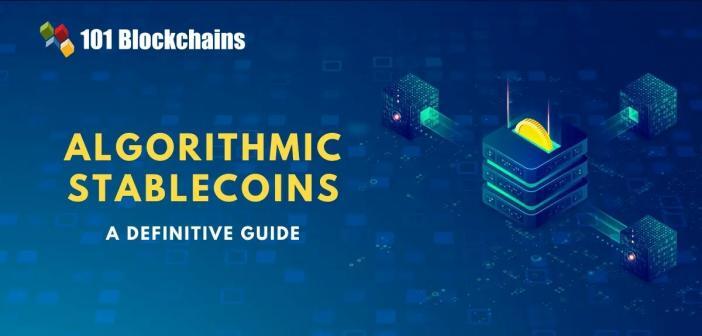Learn how blockchain truly works, master key definitions, and uncover what makes smart contracts so "smart." Dive into the fundamentals, gain valuable insights, and start your blockchain journey today!

- Cryptocurrency
Gwyneth Iredale
- on October 13, 2021
Algorithmic Stablecoins: A Beginner’s Guide
Looking for some resources to learn about algorithmic stablecoins? You’ve reached the right place, let’s dive in.
Stablecoins have emerged as one of the prominent interventions in the crypto world for addressing the concerns of volatility. Any individual following the crypto space closely would find that crypto coins and tokens are considered volatile. The value of crypto fluctuates profoundly in accordance with changes in market conditions, supply, and demand. It is important to note that high volatility in the crypto domain could present a formidable concern for investors.
Therefore, stablecoins were developed as a reliable solution for addressing the high volatility in the crypto domain. Among the many types of stablecoins, algorithmic stablecoins have been touted as the ‘purely stable’ decentralized crypto tokens. Are they truly stable? What do algorithm-based stablecoins bring to the table? The following discussion offers you a detailed guide on algorithm-based stablecoins, their working, functions, and notable names in the algorithmic stablecoins list.
Want to learn the basic and advanced concepts of stablecoins? Enroll Now in Stablecoin Fundamentals Masterclass
Know about Different Variants of Stablecoins
In order to develop a better understanding of algorithm-based stablecoins, it is important to know the different types of stablecoins. Stablecoins have been quite successful in establishing a massive market presence. Interestingly, the total supply for stablecoin witnessed a drastic growth of 493% in the period of one year.
From $5.9 billion at the beginning of 2020 to more than $35 billion at the beginning of 2021, stablecoins have definitely come a long way. Most important of all, the continuous push for the DeFi market has added momentum to the impressive growth of stablecoins. In the most basic sense, stablecoins are classified into three different categories such as,
-
- Off-chain collateralized stablecoins
- On-chain collateralized stablecoins
Algorithmic stablecoins
The off-chain collateralized stablecoins are generally associated with support of bank deposits alongside ensuring regular auditing. A centralized entity mints the off-chain collateralized stablecoins alongside taking care of their maintenance.
On-chain collateralized stablecoins are associated with cryptocurrency collaterals. DeFi protocols mint such stablecoins in a permissionless approach while embedding high-quality collateral.
Want to become a Cryptocurrency expert? Enroll Now in Cryptocurrency Fundamentals Course
What are Algorithmic Stablecoins?
Algorithm-based stablecoins come in the final category and do not have any associated collateral. Therefore, they are also referred to as non-collateralized stablecoins. Algorithm-based stablecoins are completely new variants of cryptocurrency tailored for offering improved price stability. In addition, it can also help in balancing the supply and demand of the asset in circulation. Most importantly, algorithm-based stablecoins offer considerably improved capital efficiency in comparison to collateralized stablecoins.
The algorithm or the protocol is backing up these stablecoins works as the ‘central bank.’ It helps in increasing the supply in event of the deflationary tendency of the token or reducing the supply in event of a decline in purchasing power of stablecoin. The rules for such actions by the algorithm are available in smart contracts in an embedded form. It is possible to change the rules only by leveraging social consensus or through governance votes associated with governance or seigniorage tokens.
Watch This Video To Know About Algorithmic Stablecoins Right Now!
Working of Algorithmic Stablecoin
As you can clearly notice, the working of an algorithm-based stablecoin depends profoundly on an algorithm. The algorithm sets the rules for balancing the supply and demand of the stablecoin. You must be familiar with ERC-20 smart contracts and their functionalities. They ensure that the number of tokens related to a specific address is updated at every instance of transferring a token from one added to another.
In the case of the algorithm-based non-collateralized stablecoins, you can find the additional functions of minting and burning in the ERC-20 smart contracts. The functions help in effective management of the processes for updating the tokens related to the wallet. However, there is more to the working of algorithm-based stablecoins than just the ERC-20 smart contracts.
When you try to understand ‘What are algorithmic stablecoins?’ in detail, you could find that they also include oracle contracts. The oracle contract is responsible for enabling the smart contract to communicate outside the blockchain. Oracle contracts are capable of obtaining the price of a particular algorithmic stablecoin from multiple exchanges.
One of the most important examples of an oracle contract refers to Chainlink. The working of algorithmic stablecoins also involves a rebase contract. After the oracle contract finds out the price of the concerned stablecoin, it passes off the value to the rebase contract at a gap of every 24 hours. The rebase contract basically focuses on determining the ideal choice between contracting and expanding the supply.
The rebase contract sends the available information to the stabilizer contract in the next step of the working of algorithm-based stablecoins. Stabilizer contract helps in finding out the number of tokens that must be burned and minted from all user wallets related to the contract and begins the procedure.
On an overall basis, the primary logic underlying the functions of algorithm-based stablecoins relies on burning the tokens when the price of the stablecoin increases beyond the predefined stable value. On the other hand, the algorithm would facilitate minting of new tokens for instances where the price of the tokens falls lower than the predefined stable value.
Want to learn blockchain for free? Enroll Now: Enterprise Blockchains Fundamentals
Types of Algorithmic Stablecoin
Now that you know about the working of algorithm-based stablecoins, you can look forward to finding out the best algorithmic stablecoins. However, it is important to have a basic impression of the different types of algorithm-based stablecoins to understand them better. The initial variants of algorithm-based stablecoins included ‘rebase’ coins such as the Ampleforth or AMPL token. The rebase coins helped in adjusting the supply in accordance with the existing market rate for AMPL.
When AMPL trades above $1.05 and less than $0.95, the protocol issues new tokens to the holders or destroys them from holders accordingly. As a result, it can help in transferring volatility from price to market cap with better effectiveness. Therefore, the market capitalization changes according to change in demand for rebasing tokens, without price changes. However, the model of the initial algorithm-based stablecoins.
AMPL is an example of one of the first types of algorithmic stablecoins, which followed a single-token model. In this model, token holders could gain benefits from the growing supply on the grounds of increasing demand. On the other hand, the risks of algorithmic stablecoins become evident in the single-token model. How? Token holders in this model have the responsibility of financing a re-peg in event of shrinking demand or trading of the token below specified threshold by means of supply contraction.
The second variant among answers to ‘What are algorithmic stablecoins?’ would draw you to multi-token models. Many stablecoins leveraging the multi-token model rely on separation of the stablecoin functionality from other features of the protocol. So, the stablecoin function is different from other functionalities such as value accrual or governance.
Metrics for the Success of Algorithmic Stablecoins
Most of the discussions surrounding an explanation for algorithm-based stablecoins point to an outline of the best algorithmic stablecoins. However, it is important to know the distinct factors which establish the effectiveness of algorithm-based stablecoins. This is where you need to focus on the key areas for analysis of algorithm-based stablecoins and the metrics for evaluating their performance.
Comparison of different protocols for algorithm-based stablecoins is quite difficult. However, an evaluation of the critical aspects in market design, token design, and mechanism design could help in discovering the efficiency of algorithm-based stablecoins. Here are some of the important factors which you should take into account for determining the effectiveness of algorithmic stablecoins.
-
Governance
Many algorithm-based stablecoin protocols supposedly feature a DAO structure. However, only a selected assortment of protocols features an active community responsible for consistently approving improvement proposals. A functional governance smart contract might seem like the ideal choice for ensuring governance in non-collateralized stablecoins. However, it is also important to ensure fair token distribution alongside offering adequate governance privileges to all the stakeholders. Various types of algorithmic stablecoin protocols follow a de facto centralized governance approach.
-
Incentives
You can find that certain algorithm stablecoin protocols choose the rebase mechanism in cases where they have to ensure active modification of a number of tokens in a user’s wallet. On the other hand, some protocols aimed at offering returns on alternative investment vehicles such as coupons for removing or adding supply and matching the demand.
Therefore, incentives stand as one of the toughest aspects in determining the efficiency of the best algorithmic stablecoins. Why? You have the instability of the crypto market alongside the fluctuating elements in human psychology and economics. As of now, the only visible incentive with stablecoins is stability.
-
Token Adoption
The factor of token adoption is also an important aspect in defining the ideal choices in an algorithmic stablecoins list. Majority of protocols are adopted only by a trivial number or a specific limit of DeFi projects. Automated Market Makers, which do not need approval from the partner protocol, are excluded from the adoption. As a result, the usefulness of the algorithm-based tokens takes a dip alongside restricted exposure to new users. The limited levels of token adoption could present limitations for stability on the grounds of slower liquidity growth.
-
Accuracy
Algorithmic stablecoins struggle considerably in maintaining the peg on the grounds of different complicated reasons. Certain protocols could go out of control to an extent where they are likely to fall in a ‘death loop.’ As a result, a major protocol would be in order to help the protocol move out of the ‘death loop.’
Want to learn about the important traits of stablecoins? Check here Know The Key Features Of Stablecoins now
Risks of Algorithmic Stablecoins
The most critical factor in an explanation for non-collateralized stablecoins would point out the risks associated with them. In order to understand the different risks associated with algorithm stablecoin protocols, let us take the example of Basis, an uncollateralized stablecoin. Here are some of the notable entries among risks you can find with algorithm-based stablecoins.
-
Increase in Supply
Weren’t the best algorithmic stablecoins tailored for balancing the supply of stablecoin? How does it pose risks to token holders? When the price of the token increases above the predefined stable value, the algorithm mints new tokens for increasing supply. In the case of Basis, you can find Share tokens according to which the holders of shares receive newly minted stablecoins in event of increased supply.
On the other hand, the shares could get new tokens only after payments to the bondholders. Payment of newly minted tokens infuses value in the shares, albeit depending considerably on increasing demand. In event of a slowdown in demand growth, new stablecoins must be minted, thereby leading to loss of value of shares.
-
Reducing Supply
The reduction in supply also presents another notable addition to the risks of algorithmic stablecoins. One of the common approaches for reducing supply with algorithm-based stablecoins is the facility of ‘bonds.’ Such bonds are on sale in an open market for a lesser value than the predefined stable value. Payment for the bonds is carried out by using stablecoin with a promise of returning one stablecoin in the future. However, buyers need to invest their confidence in the fact that the bonds will payout at a specific point in time.
-
Oracles
Another top addition among the risks of algorithmic stablecoins refers to oracles. Oracle contracts are responsible for offering the price data related to the concerned stablecoin. Subsequently, the algorithm ensures adjustments in the supply with knowledge of the price. However, the selection and implementation of oracles can present formidable challenges, especially considering the aspects of trust, honesty, and accuracy.
-
Broken Pegs
The final entry among the challenges associated with non-collateralized stablecoins refers to broken pegs. Peg breaks are considerably worst scenarios for any type of stablecoin, and uncollateralized stablecoins run the maximum levels of risk. Why? They depend considerably on market confidence. Without market confidence, a token or coin could gradually fade away into oblivion. If any stablecoin encounters two prominent peg breaks, then they would encounter prominent difficulties in recovering effectively.
Notable Examples of Algorithm-based Stablecoins
Understanding algorithm-based stablecoins could become easier with insights into examples of some of the best algorithmic stablecoins. Here are some of the top additions among algorithm-backed stablecoins which can help you learn more about the functionalities of such stablecoins.
-
RAI
RAI provides a stablecoin protocol with the capabilities for eschewing the fiat-pegging aspect in stablecoins. It features considerable similarities with the deprecated, single-collateral DAI by MakerDAO. Users could deposit Ether in a ‘safe,’ just like DAI vaults. The minimum collateralization rate in the case of this example in algorithmic stablecoins list is just below 150%. Users would receive RAI tokens in return. The algorithm of RAI features a dedicated PID controller, which receives an input of the existing price of RAI. Then, it makes adjustments in the supply according to the price by following a continuous feedback loop.
Most importantly, all the parameters are hard-coded in the algorithm alongside ensuring responsive, automatic reactions to market data without direct manual intervention. Apart from the value benefit of ‘self-peg,’ RAI presents considerable differences from DAI in terms of governance. It aims to take various parameters of governance out of the process in 2022, thereby reducing the need for depending on governance.
-
FEI
FEI is also another notable protocol you could find in an algorithmic stablecoins list. It focuses on addressing the capital inefficiencies identified in the case of stablecoins such as DAI. FEI presents stark differences in comparison to other algorithm-based stablecoins. One of the foremost differences refers to the fact that it does not feature the mechanism for swapping collateral for stablecoin. On the contrary, digital wealth comes into the system by leveraging a bonding curve, which sells FEI in exchange for ETH. Then, the digital wealth remains locked in the Protocol Controlled Value or PCV, which is basically the pool of collateral for the stablecoin.
PCV helps in maintaining the peg by managing liquidity on exchanges like Uniswap. With the limitations on sell-side liquidity, FEI is one of the best algorithmic stablecoins for avoiding the ‘death spiral’ scenario. The FEI protocol leverages its TRIBE token for enabling holders to determine the following aspects of governance,
-
- Addition of new bonding curves for selling additional FEI
- Determining the approach for allocation of PCV value
- Modifications in other parameters of governance
-
FRAX
The final addition among the popular non-collateralized stablecoins right now would bring FRAX into the equation. FRAX follows the assumption that a stablecoin could be secure as well as partially collateralized, with a system relying on arbitrage. Collateralization of FRAX with USDC at a ratio that keeps the total USDC backing at a lower level than the total supply of FRAX.
Apart from its under-collateralized nature, FRAX also leverages USDC in place of ETH. Another crucial highlight about FRAX as one of the top additions in an algorithmic stablecoins list refers to its governance. FRAX follows a governance-minimized approach to enable considerably lesser algorithmic dials for the community to modify.
Excited to learn about the top algorithm stablecoins? Read here for the List Of Top 5 Algorithmic Stablecoins now!
Final Words
The introduction of algorithmic stablecoins has definitely provided the ideal prospects for ensuring decentralization without any regulatory bodies. With the foundational benefits of algorithm-based stablecoins, you can have a truly scalable solution in comparison to other alternatives. In addition, the lack of requirements for tangible assets backing up the non-collateralized stablecoins also reduces the chances of human error.
Algorithm-based stablecoins rely on code that is transparent and auditable, thereby presenting favorable prospects for building trust. The understanding of different types of algorithm stablecoins, metrics for their success, and risks associated with them could help you discover their true potential. As new examples of algorithm-backed stablecoins emerge, it is important to learn about the value they can bring to the crypto ecosystem. Dive into the world of stablecoins right now!
*Disclaimer: The article should not be taken as, and is not intended to provide any investment advice. Claims made in this article do not constitute investment advice and should not be taken as such. 101 Blockchains shall not be responsible for any loss sustained by any person who relies on this article. Do your own research!





